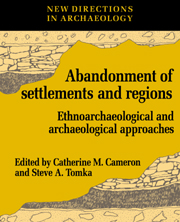Book contents
- Frontmatter
- Contents
- List of figures
- List of tables
- List of contributors
- Acknowledgments
- PART I INTRODUCTION
- PART II REGIONAL ABANDONMENT PROCESSES: ETHNOARCHAEOLOGICAL CASES
- PART III REGIONAL ABANDONMENT PROCESSES: ARCHAEOLOGICAL CASES
- PART IV ABANDONMENT PROCESSES WITHIN SITES: ETHNOARCHAEOLOGICAL CASES
- 10 Abandonment at Zuni farming villages
- 11 Abandonment and the production of archaeological variability at domestic sites
- PART V ABANDONMENT PROCESSES WITHIN SITES: ARCHAEOLOGICAL CASES
- PART VI CONCLUSIONS
- Index
11 - Abandonment and the production of archaeological variability at domestic sites
Published online by Cambridge University Press: 23 May 2010
- Frontmatter
- Contents
- List of figures
- List of tables
- List of contributors
- Acknowledgments
- PART I INTRODUCTION
- PART II REGIONAL ABANDONMENT PROCESSES: ETHNOARCHAEOLOGICAL CASES
- PART III REGIONAL ABANDONMENT PROCESSES: ARCHAEOLOGICAL CASES
- PART IV ABANDONMENT PROCESSES WITHIN SITES: ETHNOARCHAEOLOGICAL CASES
- 10 Abandonment at Zuni farming villages
- 11 Abandonment and the production of archaeological variability at domestic sites
- PART V ABANDONMENT PROCESSES WITHIN SITES: ARCHAEOLOGICAL CASES
- PART VI CONCLUSIONS
- Index
Summary
Introduction
Since the pioneering work of Robert Ascher (1961, 1968), archaeologists have stressed the importance of studying archaeological formation processes for understanding human behavior in the past (Binford 1981a, 1981b; Schiffer 1972, 1976, 1983, 1987; Wood and Johnson 1978). A systematic understanding of archaeological formation processes provides the inferential bridge between static patterns of the archaeological record and dynamic patterns of ongoing behavior. This provides a method by which human behavior in the past can be inferred from the material patterns remaining from that behavior. At domestic sites, ignorance of archaeological formation processes has often limited the ability of archaeologists to make informed inferences concerning the activities represented by material patterning in and around house–floors (Lange and Rydberg 1972; Schiffer 1985; Stanislawski 1973). However, recent research on formation processes of domestic sites is beginning to provide the middle–range linkages needed to infer the processes responsible for the composition of domestic site assemblages (Siegal 1990; Deal 1985; Hayden and Cannon 1983, 1984; Lange and Rydberg 1972; Moore and Gasco 1990; Savelle 1984; Schiffer 1985, 1987; Stevenson 1991). Abandonment processes have been shown to be especially significant in the formation of archaeological assemblages at domestic sites (Bonnichsen 1973; Cameron 1991; Lange and Rydberg 1972; Longacre and Ayers 1968; Robbins 1973; Schiffer 1972, 1976; Stevenson 1982).
This study examines how processes of site abandonment affected material patterns at the site of La Concha, an abandoned single–family household compound in rural Mexico.
- Type
- Chapter
- Information
- The Abandonment of Settlements and RegionsEthnoarchaeological and Archaeological Approaches, pp. 138 - 154Publisher: Cambridge University PressPrint publication year: 1993
- 10
- Cited by

